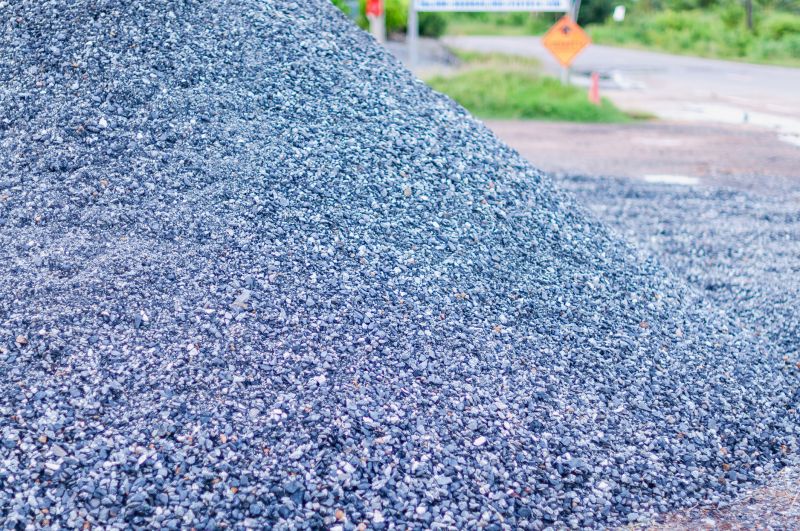Favorite Gravel Service Equipment for Efficient Site Management
Identify the most popular tools that facilitate quick setup, maintenance, and management of gravel service sites.
 Products designed for gravel service are essential tools and equipment used to maintain, repair, and enhance gravel pathways, driveways, and roads. These products range from durable machinery to specialized accessories that facilitate grading, leveling, compacting, and stabilizing loose gravel surfaces. Proper selection of these tools ensures smoother surfaces, improved durability, and safer passage for vehicles and pedestrians.
Products designed for gravel service are essential tools and equipment used to maintain, repair, and enhance gravel pathways, driveways, and roads. These products range from durable machinery to specialized accessories that facilitate grading, leveling, compacting, and stabilizing loose gravel surfaces. Proper selection of these tools ensures smoother surfaces, improved durability, and safer passage for vehicles and pedestrians.
Top Overall Option
Vibratory Plate Compactor
A vibratory plate compactor is a versatile machine commonly used to compress and stabilize gravel surfaces. It features a flat, heavy plate that vibrates to settle and compact loose gravel efficiently, making it suitable for driveway prep, walkways, and small construction projects. Its ease of use and effectiveness in achieving consistent compaction make it a popular choice among both DIY enthusiasts and professionals.
Types of Products For Gravel Service
Manual Gravel Rakes
Manual gravel rakes are essential for spreading and leveling gravel by hand, ideal for small-scale projects and touch-up work.
Vibratory Plate Compactors
These compactors use vibration to compress gravel surfaces, providing stability and reducing settling over time.
Motorized Graders
Motorized graders help in shaping and leveling large gravel areas, ensuring a smooth and even surface.
Power Tillers
Power tillers loosen and prepare gravel beds, making it easier to spread and level materials.
Hand Tamper Tools
Manual tampers are used to compact small sections of gravel, especially in tight spots or for detailed work.
Gravel Stabilizers
Stabilizers are added to gravel surfaces to improve cohesion and reduce displacement under traffic.
Drainage Gravel Accessories
Products designed to improve drainage and prevent water accumulation in gravel pathways.
Edge Restraints
Edge restraints help maintain the shape of gravel surfaces and prevent spreading into adjacent areas.
Gravel Spreaders
Manual or motorized spreaders assist in evenly distributing gravel over large areas.
Sealants and Binders
These products help bind gravel particles together, enhancing surface stability and longevity.
Wheelbarrows and Carts
Essential for transporting gravel and other materials around the work site efficiently.
Water Trucks and Sprayers
Used to wet down gravel surfaces during compaction to improve density and reduce dust.
Skid Steer Loaders
Powerful machines capable of moving large quantities of gravel, spreading and leveling as needed.
Dump Trailers
Trailers designed for hauling gravel and other aggregate materials across job sites.
Traction Mats and Grips
Accessories that provide additional grip and stability for vehicles on loose gravel surfaces.
Popular Choices
A common tool for spreading and leveling gravel in small projects or repair work.
Widely used for compacting gravel surfaces, especially in driveway and pathway installations.
Popular for preparing gravel beds and mixing materials on larger sites.
Commonly selected for improving water flow and preventing erosion in gravel pathways.
Frequently used to contain gravel and maintain defined edges in various projects.
Essential for transporting gravel and materials efficiently around the work site.
Often employed for moving large amounts of gravel quickly and with minimal manual effort.
Popular for enhancing vehicle traction on loose gravel surfaces, especially in challenging conditions.
Commonly used for small-scale compaction tasks and detailed work in confined spaces.
Manual or powered spreaders help achieve even distribution of gravel over large areas.
Popular for enhancing gravel surface stability and reducing displacement under load.
Many gravel service products are built to withstand rigorous outdoor conditions, often featuring rugged construction and weather-resistant materials. They can be operated manually or powered by engines, depending on the scope and scale of the project. For smaller residential projects, manual tools like rakes and hand tampers may suffice, while larger commercial or industrial tasks typically require motorized equipment such as vibratory plate compactors, motorized graders, or power tillers.
Maintenance is a key aspect of gravel surface management. Regular grading helps to prevent uneven settling and ruts, while proper compaction enhances load-bearing capacity and reduces dust. Additionally, accessories like gravel stabilizers and binding agents can improve surface integrity, especially in high-traffic areas. Investing in quality products tailored to specific project needs can lead to more efficient work and longer-lasting results.
Whether you are a homeowner maintaining a driveway or a contractor working on a large-scale project, understanding the variety of available gravel service products can help you make informed decisions. From basic manual tools to advanced machinery, each product plays a role in achieving a well-maintained gravel surface that meets safety and usability standards.
Key Buying Considerations
- Project scale and size to determine the appropriate equipment type and capacity.
- Frequency of use to decide between manual tools and powered machinery.
- Type of gravel surface and desired finish or stability requirements.
- Ease of operation and user familiarity with equipment.
- Durability and build quality of tools and machinery for outdoor conditions.
- Portability and storage options for equipment, especially for smaller projects.
- Compatibility with existing tools and accessories on hand.
- Availability of maintenance and replacement parts for machinery.
- Budget constraints balanced with quality and functionality.
- Safety features and ease of handling to prevent accidents.
- Versatility of equipment for multiple tasks or project types.
- Power source preferences, such as electric, gas, or manual options.
- Environmental conditions, including weather and terrain, that may affect equipment choice.
- Potential for future expansion or scaling of gravel projects.
- Availability of technical support or customer service from suppliers.
This content may contain affiliate links. We earn commissions to support our work, at no additional cost to you.
